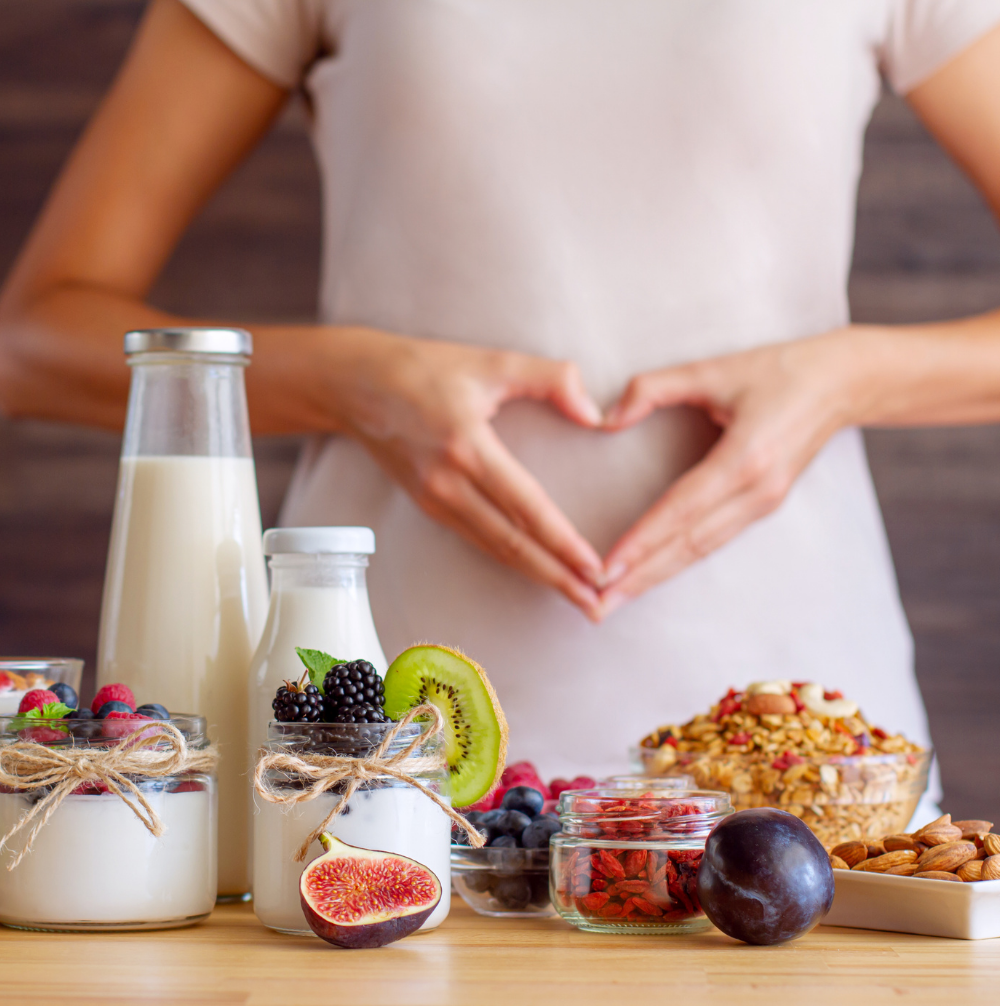World Digestive Health Day 2022

3 WAYS TO IMPROVE YOUR GUT BACTERIA
Our gut microbiome and its importance to our overall health has become a popular topic for expanding research and, in turn, a hot topic of conversation over the past few years. The more researchers explore the topic, the more microorganisms they find.
As we approach World Digestive Health Day on 29 May 2022, I thought it only fitting to have a look at the most recent research and highlight 3 simple things that we can do to improve our gut health.
To answer the question, you might all be pondering: what is our gut microbiota and why is it so important, so we need to take a deeper look at the science. The human gut is home to trillions of bacterial cells that form a living population, the microbiota.
Researchers are even moving towards describing this microbiota as a new human organ! Our gut microbiome starts to develop at birth and, in healthy individuals, can be completed within three years. Even though it is completely developed, it can still be affected by external factors such as antibiotic use, exercise and our diet. The microbiota’s interdependent relationship with its host plays a role in maintaining health (research shows an important benefit in areas of mental health and immunity) and the prevention of certain disease such as colorectal cancer.1
Now that we know the role that gut microbiota play in our bodies, how can we ensure that it stays healthy?
Here are 3 simple ways that you can improve your gut bacteria:
1. Increase your fibre intake:
Our more Western-style diet tends to be low in fibre and high in sugar and fat. This has led to a change in our gut microbiome profile, particularly the type of bacteria we find in our gut, reducing the protective nature of our microbiota. Having a diet that is low in fibre has been shown to have a negative relationship with our gut bacteria. This negative relationship has been shown to increase the risk of inflammatory disease including certain cancers and allergies2.
Like the rest of our organs, our gut microbiota is also dependant on energy for survival. This mostly comes from the food residue, fibre1. Adults need between 25 and 30g of fibre per day3.
There are two types of fibre, soluble and insoluble, each playing an important role in our gut. As its name suggests, soluble fibre absorbs water and is easily fermentable by our gut bacteria. Excellent food sources of soluble fibre include fruits and vegetables, barley, oats and legumes. Insoluble fibre plays a part in keeping our bowel movements regular. Food sources of insoluble fibre are nuts, whole grains, seeds, wheat and bran4.
Increasing your fibre intake might be easier said than done and many people do not meet their daily requirements!
Simple tips include choosing fruits and vegetables as snacks throughout the day - and yes, the skin must be consumed too, - or by adding grated vegetables and legumes to meals, or choosing high fibre breakfast options like FUTURELIFE® Bran Flakes and Barley, which has a whopping 9.9g of fibre per serving (39% of your daily recommendations). FUTURELIFE® Kid’s Cereal and FUTURELIFE® Granola Crunch Smart food™ Vitality with real Berries are also high in dietary fibre and are great options to help you meet your daily requirements.
Fibre and fluids go hand in hand so remember to drink enough water throughout the day too!
2. Probiotics:
A fitting place to start, when it comes to probiotics, is to look at what the World Health Organisation (WHO) defines probiotics as. WHO defines them as “live microorganisms that, when administered in adequate amounts, confer a health benefit to the host”5.
Probiotics have received a lot of attention over the past few years because of the important role they play in our gut health. Probiotics are live microorganisms and their main function is to maintain a proper balance between the bacteria in our gut to ensure the adequate functioning of our gut microbiota. And that is why probiotics are often recommended when taking antibiotics because they help restore our natural microbiota6.
Food items that naturally contain probiotics include yoghurt, sauerkraut and kimchi. These are food items that might not always be included into your diet, so if you feel as though you aren’t consuming enough probiotics, they can be taken in a capsule/supplement format as a supplementary source of probiotics.
FUTURELIFE® Bran Flakes and Barley already comes with 10 capsules of HOWARU® Premium Probiotics, so you receive the benefit of the fibre as well as the probiotics all in one product! HOWARU® Premium Probiotics have been packed in individual capsules that provide a portion-controlled serving of probiotics and the correct environment to protect the sensitive probiotics.
Each HOWARU® Premium Probiotic capsule contains 1 billion colony forming units of HOWARU® Lactobacillus acidophilus and HOWARU® Bifidobacterium lactic. Each probiotic strain has been carefully selected for their specific properties in domains of gut health.
Lactobacillus acidophilus is commonly found in dairy products and attaches itself to the intestinal tract where it can protect it7.
Bifidobacterium lactic can assist in the stimulation of intestinal immunity8.
This blend of HOWARU® Premium Probiotics helps to deliver healthy digestion and natural immunity in one convenient supplement.
FUTURELIFE® Kid’s Cereal and the FUTURELIFE® Granola Crunch Smart food™ Vitality with real Berries are coated in the probiotic Bacillus coagulans that has been scientifically studied and shown to improve human health in terms of digestive health, immune health and nutrient absorption.
3. Prebiotics:
The majority of prebiotics are carbohydrates. All prebiotics are dietary fibres, but not all dietary fibres are prebiotics. Prebiotics are partial digested or undigested carbohydrates that reach our colon where they fulfil their main role of stimulating the growth of gut bacteria and modifying our gut microbiomes. They may also provide support to probiotics that are introduced into our gut microbiome - they are the fuel that feed probiotics. Potential prebiotic sources include cereals, vegetables and fruit6. Increasing your fibre intake can sequentially increase your prebiotic intake.
It is always important to remember that each person is unique, they follow a unique eating pattern and lifestyle and in turn each person will have a unique gut microbiome.
Good health is extremely important, and it starts in your gut. Our unique gut microbiome plays an important role in preventing certain diseases so put your gut first and become one step closer to a healthier you.
BY: BIANCA JONISCHKEIT (RD SA)
Purchase a World Digestive Health Day Value Pack
for R220 and stand a chance to win 1 of 3 SMEG Kettle & Toaster sets plus 2 Le Creuset coupé cereal bowls valued at over R7000 each!
SHOP HERE
REFERENCES
- Wilson AS, Koller KR, Ramaboli MC, et al. Diet and the Human Gut Microbiome: An International Review. Dig Dis Sci. 2020;65(3):723-740. doi:10.1007/s10620-020-06112-w
- Makki K, Deehan EC, Walter J & Bäckhed The Impact of Dietary Fiber on Gut Microbiota in Host Health and Disease. 2018; 23(6):705-715. DOI: https://doi.org/10.1016/j.chom.2018.05.012
- The European Food Safety Authority. EFSA sets European dietary reference values for nutrient intakes[internet]. EFSA’s Panel,2009 [updated 2010 March 10; cited 2020 Dec 18]. Available from: https://www.efsa.europa.eu/en/press/news/nda100326#:~:text=A%20daily%20intake%20of%2025,2%20diabetes%20and%20weight%20maintenance).
- Soliman GA. Dietary Fiber, Atherosclerosis, and cardiovascular disease. Nutrients. 2019;11(5):1155. Published 2019 May 23. doi:10.3390/nu11051155
- http://www.who.int/foodsafety/fs_management/en/probiotic_guidelines.pdf
- Markowiak P, Śliżewska K. Effects of Probiotics, Prebiotics, and Synbiotics on Human Health. Nutrients. 2017;9(9):1021. Published 2017 Sep 15. doi:10.3390/nu9091021
- Aimutis Microflora of The Intestine-Biology of Lactobacillus acidophilus.2014; 646-651.
- Ghoddusi HB, Tamime Microflora of The Intestine-Biology of Bifidobacteria 2014; 639-645.










